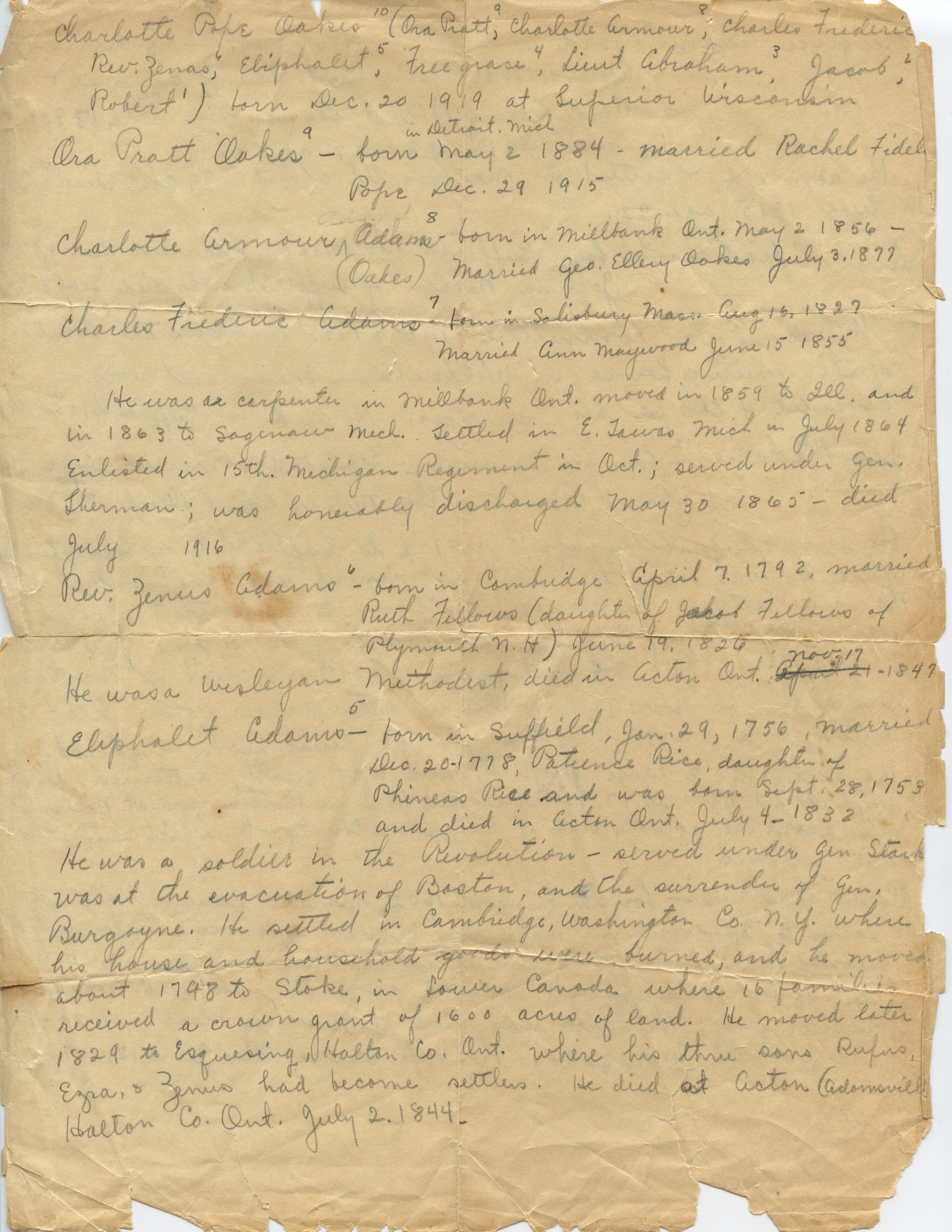Home Documents Charts People Musings

Here is yet another loose page found in the Kin book. It is also in poor shape but quite legible. The paper is also a very fine paper and must be handled with great care. Here is a transcriptions with the punctuation fixed, prepositions added, and month and place names expanded. It starts with Charlotte Pope Oakes Tamsen hence the title of the post, but it applies to all descendants of O.P. and Dee.
Note: This appears to be pulled verbatim from “A genealogical history of Robert Adams, of Newbury, Mass: and his descendents, 1635-1900”. This was authored in 1900 by Andrew Adams and is extremely extensive. You can find this on the web at books.google.com.
Charlotte Pope Oakes (Ora Pratt, Charlotte Armour, Charles Frederick, Rev. Zenus, Eliphalet, Freegrace, Lieut. Abraham, Jacob, Robert) born December 20, 1919 at Superior, Wisconsin.
Ora Pratt Oakes – born May 2, 1884 – married Rachel Fidelia Pope Dec 29, 1915.
Charlotte Armour Adams – born in Millbank, Ontario on May 2, 1856 – married George Ellery Oakes July 3, 1877.
Charles Frederic Adams – born in Salisbury, Massachusetts on Aug 16, 1827 – married Ann Maywood June 15, 1855. He was a carpenter in Millbank, Ontario. Moved in 1859 to Illinois and in 1863 to Saginaw, Michigan. Settled in East Tawas, Michigan in July 1864. Enlisted in 15th Michigan Regiment in October. Served under General Sherman. Was honorably discharged May 30, 1865. Died July 1916.
Rev. Zenus Adams – Born in Cambridge April 7, 1792. Married Ruth Fellows (daughter of Jacob Fellows of Plymouth, New Hampshire) June 19, 1826. He was a Wesleyan Methodist. Died in Acton, Ontario November 17, 1847.
Eliphalet Adams – Born in Suffield, January 29, 1756. Married December 20, 1778 to Patience Rice (daughter of Phineas Rice. Born September 28, 1753 and died in Acton Ontario July 4, 1833). He was a soldier in the Revolution. Served under General Stark. Was at the evacuation of Boston and the surrender of General Burgoyne. He settled in Cambridge, Washington County, New York where his house and household goods were burned, and he moved about 1798 to Stoke in Lower Canada where 16 families received a crown grant of 1600 acres of land. He moved later 1829 to Esquesing, Halton County, Ontario where his three sons Rufus, Ezra, and Zenus had become settlers. He died at Acton (Adamsville) Halton County, Ontario on July 2, 1844.
There are a couple of interesting things here in the story of Eliphalet. He served under General Stark in the continental army, and “was at the surrender of General Burgoyne“. The surrender would have been after the battles of Saratoga in New York. About 20 years after the war, he moves to Canada to land granted by the crown. Why? Free land is a powerful motive to move, but what, historically, was going on here? I did a cursory check of some of the land grant records in Canada and found no record of Eliphalet. Crown land grants were given to Loyalists and he certainly would not have qualified. However, he was one of 16 families. Perhaps he had a Loyalist friend who was granted more land than he could possibly work on his own? This is all fun speculation. Perhaps another Oakes knows?
But then he moves again.
This time he joins his three sons: Rufus, Ezra, and Zenus, who have settled Acton, Ontario. Zenus, in particular, would have moved from the original crown grant to Acton since he would have been a child when the family moved to Canada. In any case I found the following interesting phrase in the Wikipedia article for Acton. “Acton was first named Danville when Settler Wheeler Green opened a dry-goods store in 1828. It was later called Adamsville, after three settlers from a family of that name. In 1846, the postmaster named the community after the area of Acton in West London, England.”
All of these Canadian places are somewhat west of what is now Toronto. Acton/Esquesing is just west of Mississauga. Millbank is just northwest of Kitchener, which makes Charles Frederick Adams’ jump back into the United States much easier. Though now just a small hamlet, Millbank was a commercial center in the 1850s, primarily because of a local stream which provided the power for several mills, hence the name. It is easy to imagine the carpenter Charles being quite familiar with the owners of the local sawmill.
There’s more on the next page but that’s for another post.
Pages in this section:
Pages pointing here:
Copyright © 2024 David Dykstal. All rights reserved.